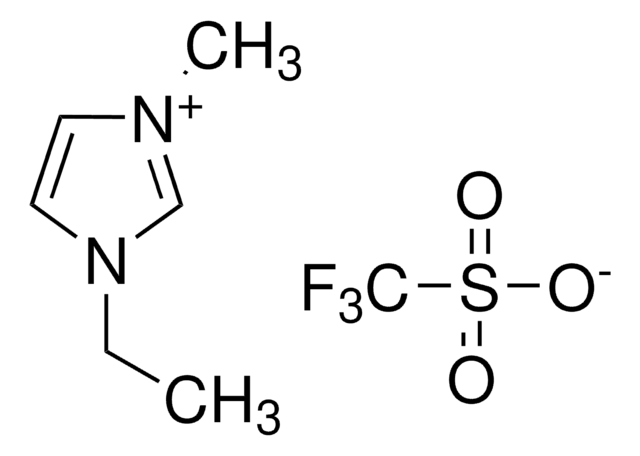Wichtige Dokumente
777048
2-[(7-{4-[N,N-Bis(4-methylphenyl)amino]phenyl}-2,1,3-benzothiadiazol-4-yl)methylene]propanedinitrile
97% (HPLC)
Synonym(e):
DTDCPB
About This Item
Empfohlene Produkte
Assay
97% (HPLC)
Form
powder
mp (Schmelzpunkt)
285-290 °C
λmax
570 nm in dichloromethane
SMILES String
Cc1ccc(cc1)N(c2ccc(C)cc2)c3ccc(cc3)-c4ccc(\C=C(/C#N)C#N)c5nsnc45
InChI
1S/C30H21N5S/c1-20-3-10-25(11-4-20)35(26-12-5-21(2)6-13-26)27-14-7-23(8-15-27)28-16-9-24(17-22(18-31)19-32)29-30(28)34-36-33-29/h3-17H,1-2H3
InChIKey
METIWNNPHPBEHP-UHFFFAOYSA-N
Allgemeine Beschreibung
Anwendung
A vacuum-deposited organic solar cell employing this novel donor-acceptor-acceptor (D-A-A) donor molecule; DTDCPB; combined with the electron acceptor C60/ C70 achieved a record-high power conversion efficiency (PCE) of 6.8%.
Device structure:
MoO3 (30nm) / DTDCPB (7nm) / DTDCPB:C70 (40nm) / C70 (7nm) / BCP (10nm) / Ag (150nm)
Device performance:
- JSC = 13.48 mA/cm2
- VOC = 0.95 V
- FF = 0.55
- PCE = 6.8%
Signalwort
Warning
Gefahreneinstufungen
Acute Tox. 4 Dermal - Acute Tox. 4 Inhalation - Acute Tox. 4 Oral - Eye Irrit. 2 - Skin Irrit. 2 - STOT SE 3
Zielorgane
Respiratory system
Lagerklassenschlüssel
11 - Combustible Solids
WGK
WGK 3
Flammpunkt (°F)
Not applicable
Flammpunkt (°C)
Not applicable
Hier finden Sie alle aktuellen Versionen:
Analysenzertifikate (COA)
Die passende Version wird nicht angezeigt?
Wenn Sie eine bestimmte Version benötigen, können Sie anhand der Lot- oder Chargennummer nach einem spezifischen Zertifikat suchen.
Besitzen Sie dieses Produkt bereits?
In der Dokumentenbibliothek finden Sie die Dokumentation zu den Produkten, die Sie kürzlich erworben haben.
Artikel
Solution-processed organic photovoltaic devices (OPVs) have emerged as a promising clean energy generating technology due to their ease of fabrication, potential to enable low-cost manufacturing via printing or coating techniques, and ability to be incorporated onto light weight, flexible substrates.
Unser Team von Wissenschaftlern verfügt über Erfahrung in allen Forschungsbereichen einschließlich Life Science, Materialwissenschaften, chemischer Synthese, Chromatographie, Analytik und vielen mehr..
Setzen Sie sich mit dem technischen Dienst in Verbindung.
